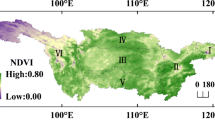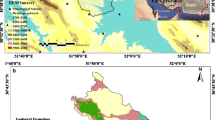Abstract
The Heihe River Basin is located in the arid and semi-arid regions of Northwest China. Here, the terrestrial ecosystem is vulnerable, making it necessary to identify the factors that could affect the ecosystem. In this study, MODIS-NDVI data with a 250-m resolution were used as a proxy for the terrestrial ecosystem. By combining these with environmental factors, we were able to explore the spatial features of NDVI and identify the factors influencing the NDVI distribution in the Heihe River Basin during the period of 2000–2016. A geographical detector (Geodetector) was employed to examine the spatial heterogeneity of the NDVI and to explore the factors that could potentially influence the NDVI distribution. The results indicate that: (1) the NDVI in the Heihe River Basin appeared high in the southeast while being low in the north, showing spatial heterogeneity with a q-statistic of 0.38. The spatial trend of the vegetation in the three sub-basins generally increased in the growing seasons from 2000 to 2016; (2) The results obtained by the Geodetector (as denoted by the q-statistic as well as the degree of spatial association between the NDVI and environmental factors) showed spatial heterogeneity in the associations between the NDVI and the environmental factors for the overall basin as well as the sub-basins. Precipitation was the dominant factor for the overall basin. In the upper basin, elevation was found to be the dominant factor. The dominant factor in the middle basin was precipitation, closely followed by the soil type. In the lower basin, the dominant factor was soil type with a lower q-statistic of 0.13, and the dominant interaction between the elevation and soil type was nonlinearly enhanced (q-statistic = 0.22).
Similar content being viewed by others
References
Ballantyne A, Smith W, Anderegg W et al., 2016. Accelerating net terrestrial carbon uptake during the warming hiatus due to reduced respiration. Nature Climate Change, 7: 148–152.
Brunsdon C, Fotheringham S, Charlton M. 1998. Geographically weighted regression-modelling spatial non-stationarity. Journal of the Royal Statistical Society, 47(3): 431–443.
Chen J, Jonsson P, Tamura M et al., 2004. A simple method for reconstructing a high quality NDVI time-series data set based on the Savitzky-Golay filter. Remote Sensing of Environment, 91: 332–344.
Cheng G D, Li X, Zhao W Z et al., 2014. Integrated study of the water-ecosystem-economy in the Heihe River Basin. National Science Review, 1(3): 413–428.
Du Z Q, Zhang X Y, Xu X M et al., 2017. Quantifying influences of physiographic factors on temperate dryland vegetation, Northwest China. Scientific Reports, 7: 40092.
Fang J, Piao S, Tang Z et al., 2001. Interannual variability in net primary production and precipitation. Science, 293(5536): 1723–1723.
Fang J Y, Piao S L, Zhou L et al., 2005. Precipitation patterns alter growth of temperate vegetation. Geophysical Research Letters, 32(21): 365–370.
Fensholt R, Langanke T, Rasmussen K et al., 2012. Greenness in semi-arid areas across the globe 1981–2007. An earth observing satellite based analysis of trends and drivers. Remote Sensing of Environment, 121(2): 144–158.
Forzieri G, Alkama R, Miralles D G et al., 2016. Satellites reveal contrasting responses of regional climate to the widespread greening of Earth. Science, 356: 1180–1184.
Gao J, Li S, Zhao Z et al., 2012. Investigating spatial variation in the relationships between NDVI and environmental factors at multiscales: A case study of Guizhou Karst Plateau, China. International Journal of Remote Sensing, 33(7): 2112–2129.
Gao J B, Fang P, Yuan L H, 2019. Analyses of geographical observations in the Heihe River Basin: Perspectives from complexity theory. Journal of Geographical Sciences, 29(9): 1441–1461.
Georganos S, Abdi A M, Tenenbaum D E et al., 2017. Examining the NDVI-rainfall relationship in the semi-arid Sahel using geographically weighted regression. Journal of Arid Environments, 146: 64–77.
Han H, Ma M, Yan P et al., 2011. Periodicity analysis of NDVI time series and its relationship with climatic factors in the Heihe River Basin in China. Remote Sensing Technology & Application, 26(5): 466–471. (in Chinese)
He B, Chen A F, Jiang W G et al., 2017. The response of vegetation growth to shifts in trend of temperature in China. Journal of Geographical Sciences, 27(7): 801–816.
Holben B N, 1986. Characteristics of maximum-value composite images from temporal AVHRR data. International Journal of Remote Sensing, 7: 1417–1434.
Huai B J, Li Z Q, Wang S J et al., 2014. RS analysis of glaciers change in the Heihe River Basin, Northwest China, during the recent decades. Journal of Geographical Sciences, 24(6): 993–1008.
Huete A, 1988. A soil-adjusted vegetation index (SAVI). Remote Sensing of Environment, 25: 295–309.
Ichii K, Kawabata A, Yamaguchi Y, 2002. Global correlation analysis for NDVI and climatic variables and NDVI trends: 1982–1990. International Journal of Remote Sensing, 23(18): 3873–3878.
Jiang W G, Yuan L H, Wang W et al., 2015. Spatio-temporal analysis of vegetation variation in the Heihe River Basin. Ecological Indicators, 51: 117–126.
Li S C, Zhao Z Q, Wang Y et al., 2011. Identifying spatial patterns of synchronization between NDVI and climatic determinants using joint recurrence plots. Environment Earth Science, 64(3): 851–859.
Li X, Cheng G, Liu S et al., 2013. Heihe Watershed Allied Telemetry Experimental Research (HiWATER): Scientific objectives and experimental design. Bulletin of the American Meteorological Society, 94(8): 1145–1160.
Luo W, Jasiewicz J, Stepinski T et al., 2016. Spatial association between dissection density and environmental factors over the entire conterminous United States. Geophysical Research Letters, 43(2): 692–700.
Ma M G, Frank Veroustraete, 2006. Inter-annual variability of vegetation cover in the Chinese Heihe River Basin and its relation to meteorological parameters. International Journal of Remote Sensing, 27(16): 3473–3486.
Ma W Y, Wang X M, Zhou N, 2017. Relative importance of climate factors and human activities in impacting vegetation dynamics during 2000–2015 in the Otindag Sandy Land, northern China. Journal of Arid Land, 9(4): 558–567.
Matsushita B, Yang W, Chen J et al., 2007. Sensitivity of the Enhanced Vegetation Index (EVI) and Normalized Difference Vegetation Index (NDVI) to topographic effects: A case study in high-density cypress forest. Sensors, 7(11): 2636–2651.
Mi L N, **ao H G, Zhu W J et al., 2015. Dynamic variation of the groundwater level in the middle reaches of the Heihe River during 1985–2013. Journal ofGlaciology and Geocryology, 37(2): 461–469. (in Chinese)
Myneni R B, Hall F G, 1995. The interpretation of spectral vegetation indexes. IEEE Transaction on Geoscience & Remote Sensing, 33(2): 481–486.
Ning L, Zhou Y, Yang J et al., 2018. Spatial-temporal variability of the fluctuation of water level in Poyang Lake Basin, China. Open Geosciences, 10(1): 940–953.
Ning L X, Cheng C X, Shen S, 2019. Spatial-temporal variability of the fluctuation of soil temperature in the Babao River Basin, Northwest China. Journal of Geographical Sciences, 29(9): 1475–1490.
Peng J, Liu Z, Liu Y et al., 2012. Trend analysis of vegetation dynamics in Qinghai-Tibet Plateau using Hurst Exponent. Ecological Indicators, 14(1): 28–39.
Piao S, Fang J, Wei J et al., 2004. Variation in a satellite-based vegetation index in relation to climate in China. Journal of Vegetation Science, 15(2): 219–226.
Piao S, Nan H, Huntingford C et al., 2014. Evidence for a weakening relationship between interannual temperature variability and northern vegetation activity. Nature Communications, 5: 5018.
Raynolds M K, Comiso J C, Walker D A et al., 2008. Relationship between satellite-derived land surface temperatures, arctic vegetation types, and NDVI. Remote Sensing of Environment, 112(4): 1884–1894.
Seddon A W, Maciasfauria M, Long PR et al., 2006. Sensitivity global terrestrial ecosystems to climate variability. Nature, 531(7593): 229–232.
Shen S, Ye S J, Cheng C X et al., 2018. Persistence and corresponding time scales of soil moisture dynamics during summer in the Babao River Basin, Northwest China. Journal of Geophysical Research: Atmospheres, 123: 8936–8948. https://doi.org/10.1029/2018JD028414.
Song C Q, Yuan L H, Yang X F et al., 2017. Ecological-hydrological processes in arid environment: Past, present and future. Journal of Geographical Sciences, 27(12): 1577–1594.
Sun W, Song H, Yao X et al., 2015. Changes in remotely sensed vegetation growth trend in the Heihe Basin of arid northwestern China. Plos One, 10(8): e0135376.
Tong S, Zhang J, Bao Y et al., 2018. Analyzing vegetation dynamic trend on the Mongolian Plateau based on the Hurst exponent and influencing factors from 1982–2013. Journal of Geographical Sciences, 28(5): 595–610.
Tong S Q, Zhang J Q, Bao Y H et al., 2017. Spatial and temporal variations of vegetation cover and the relationships with climate factors in Inner Mongolia based on GIMMS NDVI3g data. Journal of Arid Land, 9(3): 394–407.
Tucker C, Seller P, 1986. Satellite remote sensing of primary production. International Journal of Remote Sensing, 7: 1395–1416.
Udelhoven T, Stellmes M, Del Barrio G, 2009. Assessment of rainfall and NDVI anomalies in Spain (1989-1999) using distributed lag models. International Journal of Remote Sensing, 30(8): 1961–1976.
Wang J F, Hu Y, 2012. Environmental health risk detection with Geogetector. Environmental Modelling & Software, 33: 114–115.
Wang J F, Li X H, Christakos G et al., 2010. Geographical detectors-based health risk assessment and its application in the neural tube defects study of the Heshun region, China. International Journal of Geographical Information Science, 24(1): 107–127.
Wang J F, Xu C D, 2017. Geodetector: Principle and prospective. Acta Geographica Sinica, 72(1): 116–134. (in Chinese)
Wang J F, Zhang T L, Fu B J, 2016. A measure of spatial stratified heterogeneity. Ecological Indicators, 67: 250–256.
Wang W, Feng Q S, Guo N et al., 2015. Dynamic monitoring of vegetation coverage based on long time-series NDVI data sets in northwest arid region of China. Pratacultural Science, 32(12): 1969–1979.
**ong Z, 2014. Impact of different convective parameterization on simulation of precipitation for the Heihe River Basin. Advances in Earth Science, 29(5): 290–297. (in Chinese)
**ong Z, Yan X D, 2013. Building a high-resolution regional climate model for the Heihe River Basin and simulating precipitation over this region. Chinese Science Bulletin, 58: 4670–4678.
Xu Q, Dong Y, Wang Y et al., 2018. Determinants and identification of the northern boundary of China's tropical zone. Journal of Geographical Sciences, 28(1): 31–45.
Zhang T, Shen S, Cheng CX et al., 2018. Long-range correlation analysis of soil temperature and moisture on A'rou hillsides, Babao River Basin. Journal of Geophysical Research: Atmospheres, 123: 12606–12620. https://doi.org/10.1029/2018JD029094.
Zhao X, Tan K, Zhao S et al., 2011. Changing climate affects vegetation growth in the arid region of the northwestern China. Journal of Arid Environments, 75(10): 946–952.
Zhu Y J, Wu B, Lu Q, 2012. Progress in the study on response of arid zones to precipitation change. Forest Research, 25(1): 100–106. (in Chinese)
Acknowledgments
We would like to thank the high-performance computing support from the Center for Geodata and Analysis, Faculty of Geographical Science, Bei**g Normal University [https://gda.bnu.edu.cn/].
Author information
Authors and Affiliations
Corresponding author
Additional information
Foundation: National Key R&D Program of China, No.2017YFA0604704
Author: Yuan Lihua (1988-), specialized in geographical variations analysis and human geography research.
Rights and permissions
About this article
Cite this article
Yuan, L., Chen, X., Wang, X. et al. Spatial associations between NDVI and environmental factors in the Heihe River Basin. J. Geogr. Sci. 29, 1548–1564 (2019). https://doi.org/10.1007/s11442-019-1676-0
Received:
Accepted:
Published:
Issue Date:
DOI: https://doi.org/10.1007/s11442-019-1676-0




